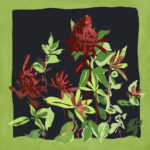 Thank you to those of you who joined me today to experiment with the ancient prayer form known as the collect. And thank you for forming such a beautiful community of practice. I will miss you during these months I am away and look forward to reconnecting in the fall.
Thank you to those of you who joined me today to experiment with the ancient prayer form known as the collect. And thank you for forming such a beautiful community of practice. I will miss you during these months I am away and look forward to reconnecting in the fall.
Pádraig Ó Tuama’s video that introduced us to the collect practice is embedded below, or you can access it on YouTube here. You can hear an interview between Krista Tippett and Pádraig on how “Belonging Creates and Undoes Us” on the On Being podcast, available here. And you can learn more about his latest projects on his website.
Some of you asked for resources to help establish or maintain a practice. Over time, consistency is more important that duration, and especially if you are somewhat new to practice, I highly recommend Mindfulness Daily a 40-day free course of 15-minute segments offered by Jack Kornfield and Tara Brach. In fact, it’s a gem for all of us, no matter what level of experience, and the episodes bear returning to time and again.
If you are experiencing chronic pain, the usefulness of Mindfulness Based Stress Reduction (MBSR) has been well vetted in the medical community. Many hospitals and wellness centers offer courses. Jon Kabat-Zinn is the godfather of the form, and his book Full Catastrophe Living is a good introduction, and you can supplement it with some of the many meditations he offers on YouTube. There are also many in-depth online courses available. Some initial scouting indicates that they generally run about $200 for an 8-week course. I can’t personally vouch for any particular offering. SoundsTrue out of Boulder, Colorado is highly reputable in its offerings for spiritual training and meditation and provides the interface for much of Jack Kornfield and Tara Brach’s online teaching. They have several offerings for MBSR.
There are also innumerable meditation apps available. Insight Timer is probably the most well known and offers a simple timer to use on your own, all sorts of guided meditations, and the option to join an online community.
Peace be with you all, and I’ll be back in touch in the fall!
With love, Teresa






 Over the past many years, scientists have been studying the neurological and physiological effects of meditation and other mindfulness practices.
Over the past many years, scientists have been studying the neurological and physiological effects of meditation and other mindfulness practices. 

 Today’s mindful pause focused on nurturing the strength and support we already carry within us by “resourcing,” consciously drawing into our attention experiences of love, support, and wisdom. These resources can include, to name just a few, our breath and sense of grounding on the earth; people who love us, both living and dead; spiritual figures such as Jesus or Buddha or Ganesh; the support of the air and water, as well as other aspects of nature and the wild; and memories of balance and equilibrium.
Today’s mindful pause focused on nurturing the strength and support we already carry within us by “resourcing,” consciously drawing into our attention experiences of love, support, and wisdom. These resources can include, to name just a few, our breath and sense of grounding on the earth; people who love us, both living and dead; spiritual figures such as Jesus or Buddha or Ganesh; the support of the air and water, as well as other aspects of nature and the wild; and memories of balance and equilibrium.